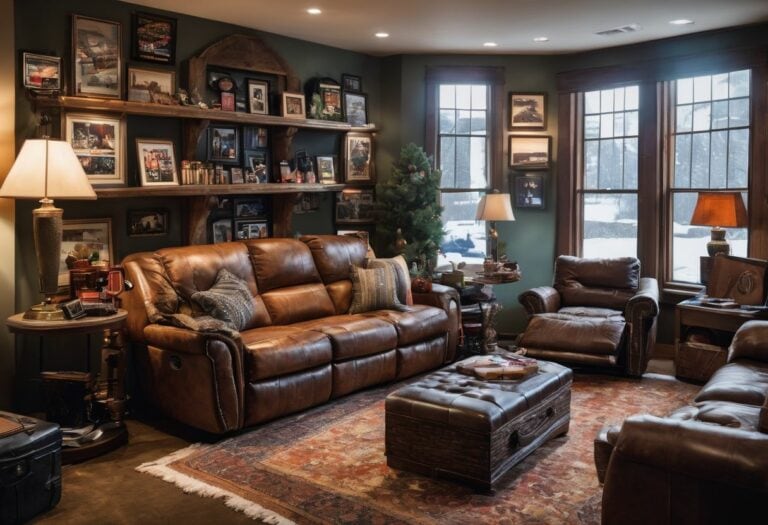Unraveling the Mystery: Why Is Furniture So Expensive in 2023?
Ever found yourself scratching your head at the sky-high prices of furniture in 2023? Trust me, you’re not alone. And guess what? Apparently, the furniture industry had been putting a lid on price jumps for years! In this blog, we’ll dive deep into why these costs have gone through the roof recently, examining factors like shifting demand trends and the influence of inflation.
Let’s unravel this mystifying trend together – it promises to be a fascinating journey!
Key Takeaways
- Furniture prices have skyrocketed in 2023 due to various factors, including markup and retail costs, the impact of imported furniture, demand and supply dynamics, and the longevity of furniture.
- The rise of fast furniture has contributed to the expensive prices. Fast furniture is affordable but often made from low-quality materials, leading to environmental consequences and a wasteful cycle.
- Marketing plays a significant role in determining furniture prices as it influences consumer demand and creates perceived value. Different prices from the same suppliers can be attributed to marketing tactics and pricing strategies employed by companies.
Why Is Furniture So Expensive in 2023: Factors Affecting Furniture Prices

Factors affecting furniture prices include markup and retail costs, the impact of imported furniture, demand and supply dynamics, and the longevity of furniture.
Markup and retail costs
I know how the price tag on a piece of furniture can make you gasp. Part of that cost comes from markup and retail costs. Furniture stores need money to pay for things like workers, rent, and other bills.
So they add extra money to the price they paid for the item. This is called markup. It’s a key factor in setting the final price that you see in the store or online.
Impact of imported furniture
Imports have a huge role in the cost of furniture. Many items come from other countries. We bring tables, chairs and sofas from places like China, Vietnam, and India. But things are not smooth now.
The world faces a big problem. COVID-19 messed up our supply chains. This means that moving goods from one place to another is tough today. It takes more time to get your bed or desk at home now due to shipping delays And extra time means extra money.
Not just this, making furniture also takes longer now because of manufacturing delays caused by the pandemic itself. Then there’s the imbalance between supply and demand which makes things worse.
But it gets even harder when we put trade tariffs into play! Yeah, you got that right! Imported goods sometimes face taxes called tariffs These can make prices rise too.
That’s how imported furniture impacts its cost for us all in 2023!
Demand and supply
Prices for furniture are going up. Why? Demand and supply play a big part. More people want to buy home decor now. This makes the need for furniture grow fast. But there is trouble in getting things we need to make it.
Raw materials cost more, and there are issues with getting them where they need to go on time. This is called a supply chain problem. With higher costs and delivery delays comes higher prices for you when buying new furniture.
Longevity of furniture
Furniture used to last for generations, but now it barely survives a move. The longevity of furniture plays a significant role in its price. When furniture is made with high-quality materials and excellent craftsmanship, it tends to be more durable and long-lasting.
This means that you won’t have to replace your furniture as often, saving you money in the long run. On the other hand, cheaper furniture may not hold up well over time and may need to be replaced sooner, increasing your expenses.
So when considering buying furniture, it’s important to invest in pieces that are built to last.
Additionally, the construction and design of furniture can impact its lifespan. Well-constructed furniture with strong joints and sturdy frames will withstand everyday wear and tear better than poorly made pieces.
Similarly, choosing timeless designs instead of trendy ones can ensure that your furniture remains stylish for years to come. Remember, taking proper care of your furniture through regular maintenance such as cleaning and polishing can also contribute to its longevity.
The Rise of Fast Furniture

Fast furniture has emerged as a dominant force in the market, catering to cost-cutting Millennials and Gen Z consumers. Discover the consequences of this trend and its impact on rising furniture prices in 2023.
How it became dominant in the market
Fast furniture has quickly risen to dominance in the market, mainly because of its affordability. With its low price point, fast furniture has become accessible to a wide range of consumers.
This mass-produced furniture is designed to be inexpensive, making it an attractive option for those on a budget or looking for quick and easy furnishing solutions. The rise of online shopping platforms and the increasing demand for convenience have also contributed to the popularity of fast furniture.
As a result, traditional furniture retailers have had to adapt and compete with these lower-cost alternatives.
Cost-cutting for Millenials and Gen Z
As a millennial or Gen Z, it’s important to find cost-cutting strategies when it comes to furniture. With the rising costs in 2023, we need to be smart about our purchases. One way to save money is by exploring fast furniture options that are affordable and convenient.
However, it’s essential to remember the financial implications and environmental impact of fast furniture. Another option is to consider restoring and repairing furniture, which can help prolong its lifespan and reduce expenses in the long run.
By being mindful of our choices and looking for ways to save money without sacrificing quality, we can navigate the expensive furniture market more effectively as millennials or Gen Z.
The consequences of fast furniture
Fast furniture has become increasingly popular due to its low cost and easy accessibility. However, there are important consequences associated with this type of furniture. One major consequence is the negative impact on the environment.
Fast furniture is often made from low-quality timber, which contributes to deforestation and loss of biodiversity. The mass production of fast furniture also leads to a wasteful cycle, as it is difficult to repair or refurbish when damaged.
As a result, many people end up discarding their fast furniture and contributing to waste in landfills. It’s crucial for consumers to be aware of these consequences and consider more sustainable options when furnishing their homes.
The Role of Marketing in Furniture Prices
Marketing plays a crucial role in determining furniture prices, as it has the power to influence consumer demand and create perceived value for certain products.
Influencing consumer demand
Marketing plays a crucial role in influencing consumer demand and the pricing of furniture. Through various advertising tactics, furniture companies aim to attract consumers and create a desire for their products.
They use market research to understand consumer preferences and target specific audiences. By positioning their brands strategically and differentiating their products from competitors’, they try to establish a competitive advantage.
Additionally, with changing market trends, companies adjust their pricing strategies to meet the demands of consumers. This includes offering cost-effective production methods while maintaining product quality.
Different prices from the same suppliers
I noticed something interesting while researching furniture prices for 2023. Even though different furniture companies use the same suppliers, they charge different prices for their products.
This can be confusing for consumers who expect consistency in pricing. However, it seems that the variation in prices is due to the role of marketing tactics and pricing strategies employed by these companies.
By using various pricing techniques and appealing to different consumer segments, furniture companies are able to set their own prices and create a competitive market. While this may seem unfair, it also allows consumers to choose from a range of options based on their budget and preferences.
Evolving market and consumer behavior
The furniture market is constantly changing as consumer behavior and preferences evolve. Demographic shifts, such as the rise of Millenials and Gen Z, have had a significant impact on the market.
These younger generations are looking for cost-effective options and convenient shopping experiences. Online retail has become increasingly popular, allowing consumers to browse and purchase furniture from the comfort of their own homes.
With more people buying furniture online, manufacturers are adapting their marketing strategies to reach these consumers effectively.
In addition to convenience, sustainability has also become a priority for many consumers. They are now seeking eco-friendly furniture options that align with their values. This shift in consumer preference has led manufacturers to invest in sustainable practices and materials.
Moreover, market competition plays a crucial role in shaping pricing strategies. Furniture brands compete with each other not only on price but also on quality, design, and customer service.
To stand out from the competition, some brands focus on creating unique offerings or targeting niche markets.
The Impact of Inflation on Furniture Prices
Inflation directly affects furniture prices, as rising property values and manufacturing costs contribute to higher prices in the industry.
Property values and manufacturing costs
The cost of furniture is going up in 2023 because of inflation and other factors. Here are some important facts about property values and manufacturing costs:
- Property values: When property values increase, it becomes more expensive for manufacturers to rent or buy space for their factories. These increased costs are then passed on to consumers through higher furniture prices.
- Manufacturing costs: The cost of manufacturing furniture includes expenses like labor wages, raw materials, and equipment. When these costs go up, it becomes more expensive to produce furniture, which leads to higher prices.
- Inflationary pressure: Inflation can impact the cost of property and manufacturing materials, pushing prices higher across the industry.
- Increased material costs: Materials like wood, metal, fabric, and upholstery are essential for making furniture. If the cost of these materials increases due to shortages or higher demand, it adds to the overall manufacturing costs.
- Wage increases: Higher wages for factory workers also contribute to increased manufacturing costs. As labor becomes more costly, it affects the final price consumers pay for furniture.
Interest rate hikes and housing market
Interest rate hikes can have a big impact on the housing market. The Federal Reserve has raised interest rates 11 times, which affects the cost of financing homes. This has led to a slowdown in the rise of house prices. Mortgage rates, which are influenced by interest rates, play a major role in how higher interest rates affect the housing market. These rate hikes are implemented to slow the economy and reduce pressure on prices during periods of high inflation. They are also used to combat high inflation.
Cost-effective Furniture Shopping Tips
Plan your furniture shopping ahead of time, set a budget, explore second-hand and refurbished options, negotiate prices with sellers, and compare prices from different retailers for the best deals.
Planning and budgeting
Planning and budgeting are essential when it comes to buying furniture on a budget. To help you make the most of your money, here are some tips to keep in mind:
- Determine your needs: Before making any purchases, assess what furniture items you truly need and prioritize them accordingly. This will prevent unnecessary spending.
- Set a budget: Decide how much you’re willing to spend on furniture and stick to it. Creating a budget allows you to have a clear idea of what you can afford and helps in making informed decisions.
- Research prices: Compare prices from different stores or online platforms to find the best deals. Look out for sales or discounts that may be available during certain times of the year.
- Consider second-hand options: Check out thrift stores, consignment shops, or online marketplaces for pre-owned furniture that is still in good condition. This can be a great way to find affordable pieces while also reducing waste.
- Look for clearance or discounted items: Many retailers offer clearance sections where they sell furniture at reduced prices due to slight imperfections or discontinued models. Take advantage of these deals if they meet your needs.
- Negotiate: Don’t be afraid to negotiate the price with the seller, especially if you’re buying directly from an individual or small business. They may be willing to lower the price to make a sale.
Second-hand and refurbished options
When buying furniture, consider second-hand and refurbished options. These can be a cost-effective way to furnish your home without breaking the bank. Plus, buying used furniture helps reduce waste and has less impact on the environment. Here are some reasons why you should consider second-hand and refurbished options:
- Affordability: Second-hand furniture can be found at up to 50% cheaper than brand new furniture. This means you can save money while still getting quality pieces for your home.
- Unique Finds: Shopping for second-hand furniture gives you the opportunity to find unique and one-of-a-kind pieces.that may not be available in traditional retail stores. It adds character and personality to your space.
- Environmental Impact: By purchasing used furniture, you are reducing the demand for new production, which in turn reduces resource consumption and waste generation from furniture manufacturing.
- Quality Materials: Older furniture is often made with solid wood or high-quality materials.that may not be as prevalent in newer, mass-produced pieces. This means you can get sturdy and durable furniture that will last for years.
- Refurbished Options: If you find a piece of furniture that needs a little TLC, consider buying it and having it refurbished. Refurbishing involves repairing any damages, replacing worn-out parts, and giving it a fresh coat of paint or finish. This can give new life to an old piece of furniture at a fraction of the cost of buying new.
Negotiating and price comparison
When shopping for furniture, it’s important to consider negotiating and comparing prices. Here are some tips to help you find the best deals:
- Compare prices: Take the time to research different stores and online platforms to compare prices before making a purchase. Look out for any ongoing promotions or discounts that may lower the cost.
- Bargain with suppliers: Don’t be afraid to negotiate with furniture suppliers or retailers. They may be willing to offer you a better deal, especially if you’re buying multiple items or if they have excess inventory.
- Look for price comparison websites: Utilize websites that specialize in comparing furniture prices across various retailers. These platforms can help you find the lowest price available for the piece of furniture you’re interested in.
- Consider second-hand options: Keep an eye out for gently used furniture, either through online marketplaces or local thrift stores. Second-hand items often come at a much lower price compared to brand new ones.
- Be open to refurbished pieces: Refurbished furniture can be a budget-friendly option while still offering quality and style. Check if any reputable refurbishing companies or local artisans offer their services in your area.
The Importance of Quality and Long-lasting Furniture
Investing in durable and comfortable furniture not only enhances the overall aesthetics of your space, but it also reduces expenses in the long run. Discover how quality furniture can save you money and provide lasting value.
Investing in durability and comfort
When it comes to buying furniture, I always prioritize investing in durability and comfort. It’s important for me that the furniture I buy is long-lasting and can withstand everyday use.
This means looking for pieces that are made from sturdy materials and have a reputation for endurance. While this may mean spending a bit more initially, I believe it’s worth it in the long run because quality furniture tends to be more reliable and resilient over time.
Plus, when you invest in comfortable furniture, you’re ensuring your satisfaction and enjoyment every time you use it. So, when shopping for furniture, don’t just focus on price or style — think about the value of investing in durable and comfortable pieces that will bring you lasting happiness.
Reducing expenses in the long run
To reduce expenses in the long run, it is essential to invest in quality and long-lasting furniture. Although high-quality furniture may come with a higher price tag initially, it can save you money over time.
When you choose durable pieces made from quality materials and craftsmanship, they are less likely to break or wear out quickly. This means you won’t have to replace them as often, which can lead to significant cost savings in the future.
In addition, investing in long-lasting furniture helps decrease waste and promotes sustainability. By choosing well-made items that stand the test of time, you are reducing the demand for new products and minimizing your environmental impact.
Sustainable practices have become more important than ever before, making eco-friendly furniture a wise choice for both your wallet and the planet.
Remember that when shopping for furniture, value for money should be a priority. Consider factors such as durability, functionality, comfort, and style when making your purchasing decisions.
The Evolution of Furniture Industry in 2023
The furniture industry in 2023 is constantly evolving, adapting to changing market trends and technological advances. Keep reading to learn more about the sustainable and eco-friendly practices being implemented, as well as how the industry is keeping up with consumer demands for comfort and durability.
Adapting to changing market trends
In order to thrive in the furniture industry, it’s crucial for businesses to adapt to changing market trends. The industry is constantly evolving, and staying up-to-date with these changes is necessary for success.
This includes keeping an eye on market fluctuations and economic uncertainty, as well as understanding the demands and preferences of consumers. Adapting to changing market trends also involves embracing new technologies and practices that promote sustainability and eco-friendliness.
By staying ahead of the curve, furniture businesses can ensure their products remain relevant and appealing to customers in 2023 and beyond.
Keeping up with technological advances
Technology is rapidly changing the furniture industry, and it’s important for manufacturers to keep up with these advancements. With the rise of Industry 4.0 capabilities, integrating technology into furniture production can result in lower operational costs and increased efficiency throughout the supply chain.
However, adopting new technologies can be a challenge as well. The furniture industry must navigate rapid technological advancements and find ways to incorporate them into their production methods while improving overall efficiency.
By embracing innovation and finding ways to optimize processes with technology, manufacturers can stay competitive in this evolving market.
Sustainable and eco-friendly practices
As someone who cares about the environment and wants to make responsible choices, I’m sure you’ll be glad to know that sustainable and eco-friendly practices are a top priority in the furniture industry.
In 2023, more and more furniture manufacturers are focusing on designing products that are environmentally friendly. This means they’re finding ways to reduce waste and conserve resources during the manufacturing process.
They’re also using sustainable materials like recycled wood or bamboo instead of traditional hardwoods. It’s great news for the planet because it helps minimize our impact on natural resources and reduces pollution.
Not only is sustainability important for our planet, but it’s also becoming increasingly valued by consumers like you! People are realizing the importance of making environmentally responsible choices when it comes to furnishing their homes and businesses.
This growing demand for eco-friendly furniture is leading manufacturers to invest in technologies that can help them meet these expectations while keeping costs down.
However, there are still challenges to overcome when it comes to sustainable furniture. One of the main obstacles is high initial costs. Because sustainable materials may be more expensive than traditional ones, this often translates into higher prices for eco-friendly furniture pieces.
But rest assured, as technology advances and becomes more widespread across the industry, these costs will come down over time.
The Future of Furniture Prices
Furniture prices are expected to continue their upward trend in the coming years due to factors such as rising costs of raw materials, inflation in the industry, increasing demand for furniture, supply chain disruptions, and technological advancements in design and manufacturing.
Predictions for 2023 and beyond
In 2023 and beyond, there are some predictions about furniture prices. The lack of affordability for homeowners is expected to have a negative impact on furniture sales. This means that people may not be able to afford new furniture as easily, leading to a decline in sales.
Additionally, with interest rate hikes and a dampened housing market, the affordability crisis could continue to affect the furniture industry. On the global scale, it’s projected that the home furniture market will expand at an annual growth rate of 6.3% from 2023 to 2030.
These factors could shape future trends in furniture prices and potentially lead to a decline in projected sales.
Factors that may continue to impact prices
Looking ahead, several factors could continue to impact furniture prices in the future. One key consideration is the cost of materials and labor. If there are shortages or increased demand for certain materials, it can drive up prices.
Additionally, fluctuations in the workforce and potential increases in wages can also affect costs. Another factor is the shipping industry; if there are disruptions or rising shipping costs, it can further contribute to higher prices for furniture.
Finally, changes in consumer preferences and market trends may also influence pricing as companies strive to meet evolving demands. It’s important to keep these factors in mind when considering future furniture purchases.
Conclusion
In conclusion, the rising costs of furniture in 2023 can be attributed to various factors. These include markups and retail costs, the impact of imported furniture, demand and supply dynamics, and the rise of fast furniture.
Marketing tactics also play a role in influencing consumer demand and pricing variations from suppliers. Furthermore, inflation, property values, interest rate hikes, and changes in the housing market affect furniture prices.
Despite these challenges, cost-effective shopping tips and investing in quality furniture can help mitigate some of these expenses. The future of the furniture industry lies in adapting to market trends, technological advancements, and sustainable practices.
Forecasters predict that while prices may remain high for now due to several ongoing factors impacting the industry’s net revenue growth adversely,” impactful measures might lead to declining prices in the future.”.
FAQs
1. Why is furniture so expensive in 2023?
Furniture prices have increased in 2023 due to factors such as rising material costs, transportation expenses, and high demand for home furnishings.
2. What are the reasons behind the expensive prices of furniture?
The expensive prices of furniture can be attributed to factors like inflation, increased manufacturing costs, limited supply of raw materials, and higher wages for laborers.
3. Are there any specific materials causing the increase in furniture prices?
Yes, certain materials like wood and metal have become more costly due to scarcity or disruptions in the global supply chain, contributing to the rise in furniture prices.
4. Will furniture prices continue to rise further?
It’s difficult to predict future price trends accurately; however, if the current economic conditions persist and supply chains remain disrupted, there is a possibility that furniture prices may continue to increase.
5. Is there anything consumers can do to mitigate the impact of expensive furniture prices?
Consumers can consider alternative options such as buying second-hand or pre-owned furniture, looking for discounts or sales events from retailers, or exploring DIY projects using reclaimed materials as ways to manage their budget amidst rising furniture costs.







